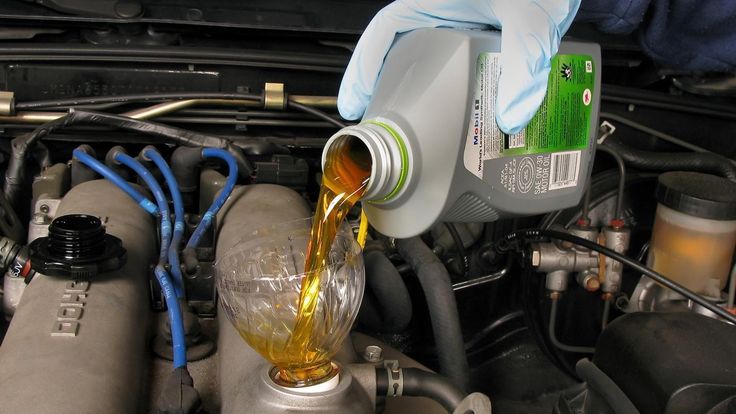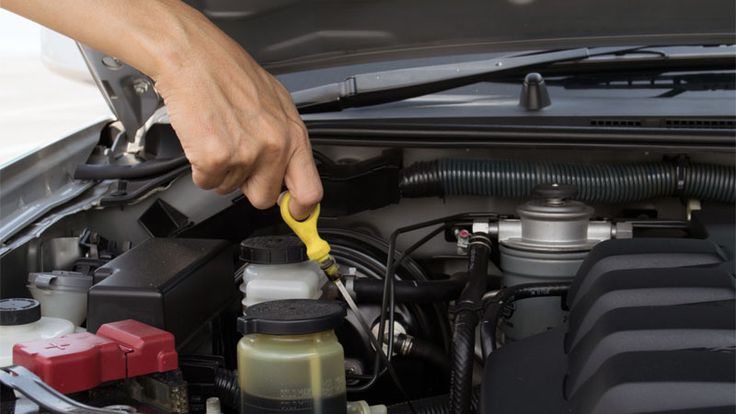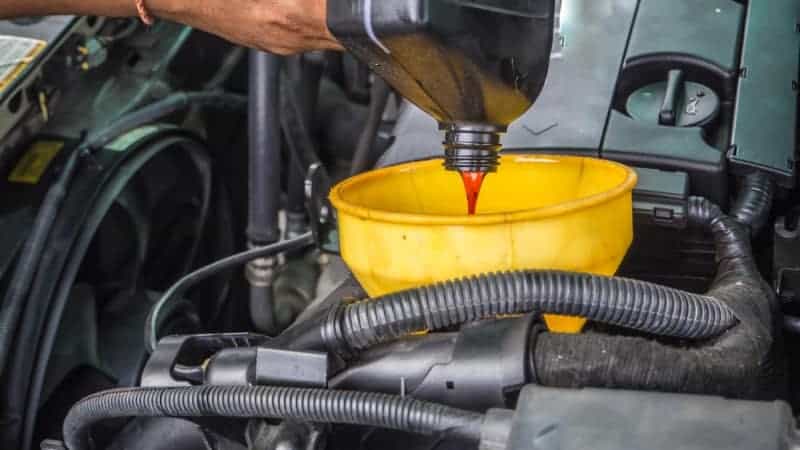The last time when you checked the transmission fluid, you noticed that there was a tiny bubble that formed on the fluid and it would make it hard to read the dipstick exactly. Although they may look harmless, they have an impact on the effectiveness of the fluid.
If more bubbles appear on the fluid, it is a sign telling you that there’s a problem with the car transmission. Regardless of where it’s coming from, bubbles in transmission fluid are a worrisome issue that requires special attention.
Contents
What Causes Air Bubbles In Transmission Fluid?
We are sure that every driver knows how transmission fluid works in your car. This fluid is a lubricant that lubricates, reduces friction, prevents rust, etc. to help the gears inside the transmission operate smoothly.
In addition, the transmission fluid also has the role of cooling the gearbox components, keeping them at the permissible temperature. Particularly for automatic transmission cars, the transmission oil is also involved in the operation of the hydraulic clutch. Therefore, ensuring the quality of transmission fluid is the key to keeping your transmission and vehicle in good condition.
To do this, drivers must check the transmission fluid regularly to detect abnormal conditions. And air bubbles in transmission fluid are one of the phenomena we want to mention in this article. What causes these bubbles and how does it affect the transmission fluid quality? Keep following up:
Overfill the fluid transmission
Everyone knows that transmission fluid has a great influence on the life of the engine and the performance of the vehicle. Therefore, many drivers often pour a little more when changing the fluid because everyone thinks “excess is better than lack”. However, anything too much is not good. When overfilling, exceeding the level specified in the manual, the residual liquid has no room to circulate.
So when the car engine is running, the gears rotate, and the excess transmission fluid will be mixed with the air. And foam appears. As you probably already know, foamy fluid cannot do a good job of lubricating machine parts. This situation goes on for a long time, leading to overheating. Even gradually damaging parts in the transmission and your car engine.

Too low fluid level
The phenomenon of lack of transmission fluid is the amount of oil is lower than the specified level or the fluid has begun to deteriorate. At that time, the parts inside the car gearbox are quickly worn and damaged, especially the gaskets and seals. This makes the transmission in the car almost impossible to operate at full capacity, causing damage to the vehicle, and even the risk of fire and explosion due to oil leaking out.
The gaskets on cars are mostly made of rubber, they are both subjected to high impact forces and subject to high-temperature changes, so they are quickly worn, cracked, broken, torn…when your transmission doesn’t have enough fluid. This allows external factors: dust and air to seep into the transmission making your fluid contaminate and creating air foam. In case of severe gasket leakage, the car will be locked, lining, and damaged. Therefore, car owners should pay attention to checking rubber gaskets and should replace new gaskets when the vehicle has operated for 10,000 km.
>> Related post: Low Transmission Fluid Symptoms To Be Aware Of
The filter is stopped up
As the name implies, a transmission filter is a component that helps remove impurities from the transmission fluid. The transmission fluid becomes bubbling due to a damaged transmission filter. It is possible that the filter is clogged or the filter is not installed properly. Maybe this is the reason to suck air into your gearbox.
Mix the transmission fluid with other additives
During maintenance or fluid change, other additives such as chlorine, soda, or borax can be mixed into the ATF. When mixed with these compounds can create a new fluid completely unsuitable for your engine. And this is what causes the bubbles in the transmission fluid. In addition, using the transmission fluid that is not according to the manufacturer’s recommendations can also lead to foaming and more serious consequences that can damage your transmission. Using the wrong transmission fluid can affect the performance and life of the gearbox. Many car manufacturers already have their own fluid for their models because differences in viscosity and heat resistance can be factors that can distort the operation of the gearbox.
Failure of the transmission pump
The pump is an important part of your car transmission. The main responsibility of this component is circulating the transmission fluid throughout the gearbox system and keeping the proper pressure. When the PT shows signs of damage, it will cause internal contamination of the transmission fluid by allowing air to enter the transmission system.
How Do The Air Bubbles Affect The Transmission Fluid In Car?
Many drivers think bubbles in transmission fluid are a simple problem and are easy to ignore. However, the consequence can be very serious, it will make your gearbox damaged and can cost you a thousand dollars to replace all the system:
When air bubbles appear and collect in your transmission fluid, the gearbox cannot do the job of heat transfer easily, and heat from its moving components is concentrated in the areas where friction happens. When this phenomenon combines with oxygen from the air, it can ignite the liquid. In this situation, drivers can feel the strange smell due to the burnt fluid, and if you check the transmission fluid you will see it come into a brown color. Replacing all the fluid is an inevitable thing.
It can cause aerated transmission fluid or you can call it “aeration”. Aeration is made by bubbles into your transmission lines and integrating with the fluid. Aerated fluid can cause numerous issues in a hydraulic and lubrication fluid system These bubbles will move throughout the gearbox system and hamper fluid efficiency, making the components have enough air to cause damage and friction.
How To Remove And Prevent Bubbles In Transmission Fluid?
If your transmission fluid starts to appear the small bubbles, you can follow these ways to get rid of this problem:
Get rid of the old fluid
When you are not careful to let other additives seep into the transmission fluid or use the wrong type of fluid, causing air bubbles, the best remedy is to replace the entire fluid.
- Firstly, you need to check the color to know if the fluid needs to be changed or not. If your car’s fluid is red or pink or light brown, it can still be used. If it is dark brown, milky brown, or has an unpleasant/pungent smell, the fluid needs to be changed.
- Preheat the engine before flushing the fluid. Draining the fluid in the automatic transmission is more complicated than diesel so you need to flush the fluid at the bottom of the crankcase and also in the torque converter.
- Adding new transmission fluid that was recommended by the manufacturers.
How to change the car transmission fluid in each vehicle is different, so you need to pay attention to find out how your car should be changed. For some vehicles, it is necessary to completely change the fluid, but in some other types, only the lost fluid should be added and not replaced.

Check the fluid level
Inspect the transmission fluid to know the condition of whether the fluid level is too much or too low.
- In this case, if you check that there’s too much fluid in the tank, you can fix it by extracting the excess fluid. There are two ways that can help you do this process: the first is to drain it from below, and the second is to suck it in from the top. You can easily drain the fluid by unscrewing the drain plug. The advantage of this method is that it doesn’t cost you too much money to do it. But it will take a lot of time to prepare and you don’t know exactly how much fluid you’re draining. To limit these disadvantages, the second method will help you. Using a liquid transfer pump makes it a lot easier to remove excess liquid. You can also use a temporary pump made from a large syringe and a rubber tube. Using these 2 methods can help you achieve your ideal transmission fluid level.
- In contrast to overfilling the fluid, you can easily repair the problem: when the transmission fluid is low by adding more fluid until it reaches the right level. On your car transmission, there are many details that are subject to friction as much as the engine. Transmission fluid is an indispensable catalyst, helping to lubricate, cool, and protect internal components to operate stably. If there is a shortage of transmission fluid, the car will operate very poorly, and even suffer major damage along with many possible dangerous problems. You can pour more fluid by removing the dipstick, placing a funnel, and adding liquid into the tank. Remember to notice the level to make sure the transmission fluid is full (but not too much).
Inspect the seals, gaskets, and filters
Seals, gaskets, and filters are the major parts and play an important role in your car transmission. When you detect something that happens to these components. You should replace them as soon as possible. Or you can take your car to the mechanic to have them check and fix it. Make sure the filter and seals are secure and all in good condition.
In some situations, when your gasket is damaged or broken, you can use the additive: head gasket sealer to quickly fix the leakages on the blown head gasket. However, when using this additive, you should follow and check the instructions on how to use this product. When poured into the vehicle, it can react with heat leaving powder deposits that accumulate over time.
>> See more: How To Check Transmission Fluid For Manual And Auto Cars
Final Thoughts
Maintaining the fluid in the transmission at the right level and making sure the quality of this liquid not only helps the car operate better and more powerfully but also increases the life of your gearbox. And bubbles in the transmission fluid are a mounting concern, which we think all drivers should check while driving because it can directly affect the efficiency of the fluid.
In the article, we shared with you the cause and some methods to help you fix this problem. With this guide, we hope that you will have a deeper knowledge to know how to solve it when you experience this situation.



